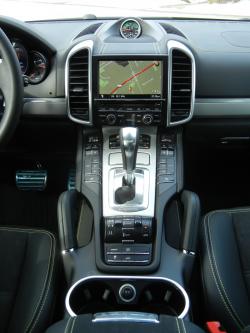The business end of the Cayenne featured highly bolstered seats, fitting for the racy purposes the GTS badge indicates. The cabin is full of rich materials befitting its price, and I’ve already mentioned the green stitching and seatbelts that stand out against the dark grey headliner and sombre black interior. Although it seems like there are entirely too many buttons for my taste, there is a lot of equipment to control (nav, premium stereo, Bluetooth phone connectivity, driving modes, etc.), and eventually they all start to make sense, especially the ones to unleash the full capability of this sports truck.
That’s right. I called this a sports truck, because that’s what it is. Even though it starts life as a tall, unwieldy, um, sport utility vehicle, Porsche’s engineering department have breathed an extra dose of sport into this chassis beyond the basic solidity I’ve experienced in its more basic Volkswagen Touareg brethren. Car and Driver provides the numbers to prove it, their test results showing acceleration numbers essentially equal to the Cayenne S, but 0.95 g on the skidpad and braking distances both better than the Cayenne S or even Cayenne Turbo, not to mention most of its super-ute competitors. On winter tires and in wintery conditions, I found the Cayenne GTS was more adept at sliding around empty parking lots than holding corners. We work with what we’ve got, right?
 2013 Porsche Cayenne GTS. Click image to enlarge |
But realistically, it was surefooted whenever I wanted it to be, the winter tires working in concert at all four corners to move it safely and surely in the snowy conditions we encountered. The parts are independent double wishbone in front and multi-link suspension in the rear, but the magic is Porsche tuning and some electronic wizardry that allows the damping rates to vary at the switch of a button… well buttons, actually, but more on those buttons later.
It may not be the fastest in the Cayenne stable (Turbo and Turbo S are on another plane of insanity) but moving this 2,085-kilo beast (4,597 lb) is no small order, and getting it up to 100 km/h in five and half seconds is plenty quick. To that effect, this naturally aspirated V8 is tuned to 420 horsepower and torque isn’t far behind at 380 lb-ft, coming on at 3,500 rpm. Horsepower peaks at 6,500 rpm, just short of its 6,700-rpm redline. I have driven more powerful cars, and faster cars, but without a track, even this much speed is excessive. Not that I don’t enjoy it, but it clearly is not necessary, but yes, it is fun and allows instantaneous acceleration at any speed.
There is a button on the console labeled Sport. Why is there even a button for that? Of course I want it pressed. It makes throttle response a bit sharper and gear changes more frantic and keeps it a gear or two lower than is strictly necessary, but the engine sure does sound nice growling away at 4,000 rpm. Gear changes of the eight-speed transmission can be left to their own devices, or you can take over control for yourself and play with the flappy paddles. I was more than happy with the regular mode, or Sport mode when the urge struck. It struck often.














